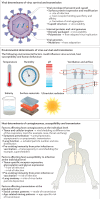Transmissibility and transmission of respiratory viruses
- PMID: 33753932
- PMCID: PMC7982882
- DOI: 10.1038/s41579-021-00535-6
Transmissibility and transmission of respiratory viruses
Abstract
Human respiratory virus infections lead to a spectrum of respiratory symptoms and disease severity, contributing to substantial morbidity, mortality and economic losses worldwide, as seen in the COVID-19 pandemic. Belonging to diverse families, respiratory viruses differ in how easy they spread (transmissibility) and the mechanism (modes) of transmission. Transmissibility as estimated by the basic reproduction number (R0) or secondary attack rate is heterogeneous for the same virus. Respiratory viruses can be transmitted via four major modes of transmission: direct (physical) contact, indirect contact (fomite), (large) droplets and (fine) aerosols. We know little about the relative contribution of each mode to the transmission of a particular virus in different settings, and how its variation affects transmissibility and transmission dynamics. Discussion on the particle size threshold between droplets and aerosols and the importance of aerosol transmission for severe acute respiratory syndrome coronavirus 2 (SARS-CoV-2) and influenza virus is ongoing. Mechanistic evidence supports the efficacies of non-pharmaceutical interventions with regard to virus reduction; however, more data are needed on their effectiveness in reducing transmission. Understanding the relative contribution of different modes to transmission is crucial to inform the effectiveness of non-pharmaceutical interventions in the population. Intervening against multiple modes of transmission should be more effective than acting on a single mode.
© 2021. Springer Nature Limited.
Conflict of interest statement
The author declares no competing interests.
Figures


References
-
- James SL, et al. Global, regional, and national incidence, prevalence, and years lived with disability for 354 diseases and injuries for 195 countries and territories, 1990–2017: a systematic analysis for the Global Burden of Disease Study 2017. Lancet. 2018;392:1789–1858. doi: 10.1016/S0140-6736(18)32279-7. - DOI - PMC - PubMed
Publication types
MeSH terms
Substances
LinkOut - more resources
Full Text Sources
Other Literature Sources
Medical
Miscellaneous

